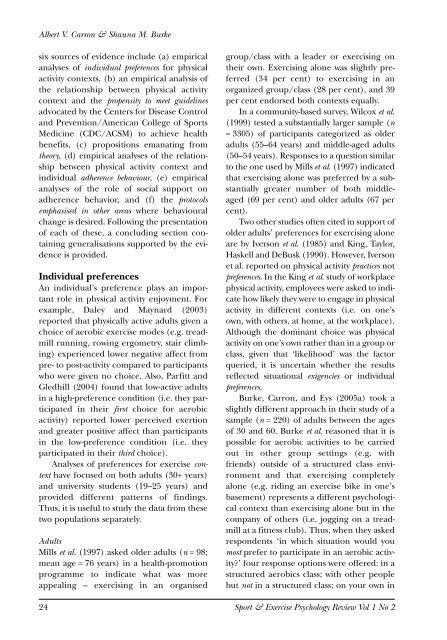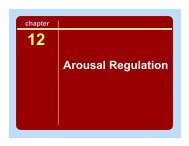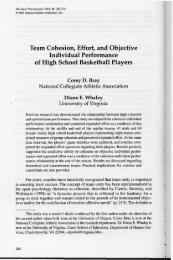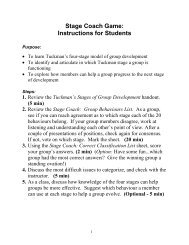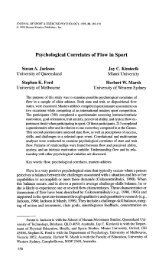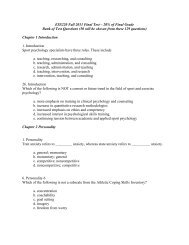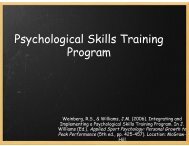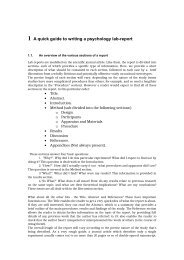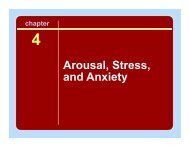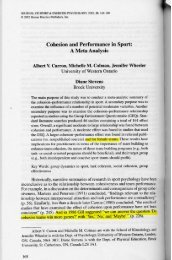Sport and Exercise Psychology Review - Sport Psychology Goes to ...
Sport and Exercise Psychology Review - Sport Psychology Goes to ...
Sport and Exercise Psychology Review - Sport Psychology Goes to ...
You also want an ePaper? Increase the reach of your titles
YUMPU automatically turns print PDFs into web optimized ePapers that Google loves.
Albert V. Carron & Shauna M. Burke<br />
six sources of evidence include (a) empirical<br />
analyses of individual preferences for physical<br />
activity contexts, (b) an empirical analysis of<br />
the relationship between physical activity<br />
context <strong>and</strong> the propensity <strong>to</strong> meet guidelines<br />
advocated by the Centers for Disease Control<br />
<strong>and</strong> Prevention/American College of <strong>Sport</strong>s<br />
Medicine (CDC/ACSM) <strong>to</strong> achieve health<br />
benefits, (c) propositions emanating from<br />
theory, (d) empirical analyses of the relationship<br />
between physical activity context <strong>and</strong><br />
individual adherence behaviour, (e) empirical<br />
analyses of the role of social support on<br />
adherence behavior, <strong>and</strong> (f) the pro<strong>to</strong>cols<br />
emphasised in other areas where behavioural<br />
change is desired. Following the presentation<br />
of each of these, a concluding section containing<br />
generalisations supported by the evidence<br />
is provided.<br />
Individual preferences<br />
An individual’s preference plays an important<br />
role in physical activity enjoyment. For<br />
example, Daley <strong>and</strong> Maynard (2003)<br />
reported that physically active adults given a<br />
choice of aerobic exercise modes (e.g. treadmill<br />
running, rowing ergometry, stair climbing)<br />
experienced lower negative affect from<br />
pre- <strong>to</strong> post-activity compared <strong>to</strong> participants<br />
who were given no choice. Also, Parfitt <strong>and</strong><br />
Gledhill (2004) found that low-active adults<br />
in a high-preference condition (i.e. they participated<br />
in their first choice for aerobic<br />
activity) reported lower perceived exertion<br />
<strong>and</strong> greater positive affect than participants<br />
in the low-preference condition (i.e. they<br />
participated in their third choice).<br />
Analyses of preferences for exercise context<br />
have focused on both adults (30+ years)<br />
<strong>and</strong> university students (19–25 years) <strong>and</strong><br />
provided different patterns of findings.<br />
Thus, it is useful <strong>to</strong> study the data from these<br />
two populations separately.<br />
Adults<br />
Mills et al. (1997) asked older adults (n = 98;<br />
mean age = 76 years) in a health-promotion<br />
programme <strong>to</strong> indicate what was more<br />
appealing – exercising in an organised<br />
group/class with a leader or exercising on<br />
their own. Exercising alone was slightly preferred<br />
(34 per cent) <strong>to</strong> exercising in an<br />
organized group/class (28 per cent), <strong>and</strong> 39<br />
per cent endorsed both contexts equally.<br />
In a community-based survey, Wilcox et al.<br />
(1999) tested a substantially larger sample (n<br />
= 3305) of participants categorized as older<br />
adults (55–64 years) <strong>and</strong> middle-aged adults<br />
(50–54 years). Responses <strong>to</strong> a question similar<br />
<strong>to</strong> the one used by Mills et al. (1997) indicated<br />
that exercising alone was preferred by a substantially<br />
greater number of both middleaged<br />
(69 per cent) <strong>and</strong> older adults (67 per<br />
cent).<br />
Two other studies often cited in support of<br />
older adults’ preferences for exercising alone<br />
are by Iverson et al. (1985) <strong>and</strong> King, Taylor,<br />
Haskell <strong>and</strong> DeBusk (1990). However, Iverson<br />
et al. reported on physical activity practices not<br />
preferences. In the King et al. study of workplace<br />
physical activity, employees were asked <strong>to</strong> indicate<br />
how likely they were <strong>to</strong> engage in physical<br />
activity in different contexts (i.e. on one’s<br />
own, with others, at home, at the workplace).<br />
Although the dominant choice was physical<br />
activity on one’s own rather than in a group or<br />
class, given that ‘likelihood’ was the fac<strong>to</strong>r<br />
queried, it is uncertain whether the results<br />
reflected situational exigencies or individual<br />
preferences.<br />
Burke, Carron, <strong>and</strong> Eys (2005a) <strong>to</strong>ok a<br />
slightly different approach in their study of a<br />
sample (n = 220) of adults between the ages<br />
of 30 <strong>and</strong> 60. Burke et al. reasoned that it is<br />
possible for aerobic activities <strong>to</strong> be carried<br />
out in other group settings (e.g. with<br />
friends) outside of a structured class environment<br />
<strong>and</strong> that exercising completely<br />
alone (e.g. riding an exercise bike in one’s<br />
basement) represents a different psychological<br />
context than exercising alone but in the<br />
company of others (i.e. jogging on a treadmill<br />
at a fitness club). Thus, when they asked<br />
respondents ‘in which situation would you<br />
most prefer <strong>to</strong> participate in an aerobic activity?’<br />
four response options were offered: in a<br />
structured aerobics class; with other people<br />
but not in a structured class; on your own in<br />
24 <strong>Sport</strong> & <strong>Exercise</strong> <strong>Psychology</strong> <strong>Review</strong> Vol 1 No 2


